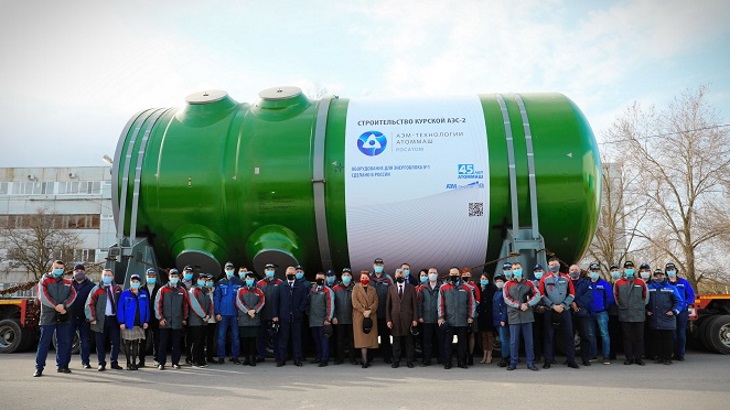The 1255 MWe VVER-TOI is a Generation III+ power unit developed using technical results from the VVER-1200 project. The design offers improved safety measures, including an increased margin of safety from extreme impacts and ability to withstand earthquakes, and is equipped with modern control systems and diagnostics. Construction work on the first of two units at Kursk II began in April 2018, and on unit 2 in April 2019. The Kursk region is in western Russia, located at the confluence of the Kur, Tuskar, and Seym rivers.
AEM Technology is part of Rosatom's engineering division, Atomenergomash. Andrey Nikipelov, the head of Atomenergomash, took part in the ceremony dedicated to the shipment of the RPV.
"The main difference between VVER-TOI and previous projects with VVER-1200 reactors is its 'typing' through the use of information technology," Nikipelov said. "Regardless of where the nuclear power plant will be built, developers and equipment manufacturers will be able to use a single information base with existing proven solutions and adapt them to each specific project."
Developed by the Gidropress Design Bureau, the VVER-TOI improves on the VVER-1200 design through increased capacity, enhanced technical and economic indicators, and an increased resistance to extreme external influences and natural disasters, Rosatom said.
The new reactor vessel is made from nickel-free steel and consists of four welded parts, compared with six for a VVER-1200 RPV. The weight of the product is about 340 tonnes. Hydraulic tests on the RPV were conducted at a pressure of 24.5 MPA (250 atmospheres), which is 1.4 times higher than the working pressure, Rosatom said.
"Creating any new high-tech product, much less a new generation reactor, is always an important task," said Igor Kotov, the head of AEM Technology. "On the one hand, in the case of VVER-TOI and the equipment for it, the basic design solutions are already quite well known and worked out by us in practice, in production. On the other hand, in nuclear engineering terms, any changes to the manufacture of a new product entail a series of decisions to adapt the process. And these are quite long and complex processes. To date, we have made progress quite successfully," he added.
The VVER-TOI RPV will be transported by road to the Tsimlyansk reservoir, and then by water along the Don and Volga to the pier in the city of Voronezh. It will then be loaded back onto vehicles and driven to the Kursk town of Kurchatov. The journey includes 1500 km by water and 300 km by road, crossing nine bridges.





_30199.jpg)
_72306.jpg)

_49562.jpg)





